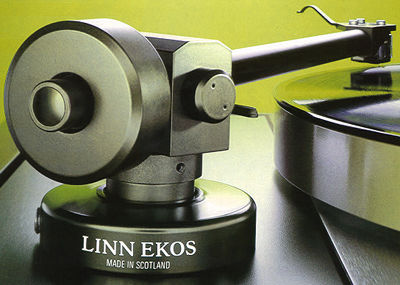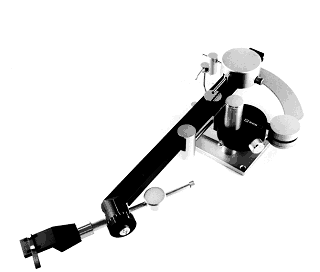Tonearm enthusiasts had a fantastic year in 1987. After what seemed like an eternity of waiting, not one, but two – then three – buses arrived at the same moment. The first was the SME Series V, which has gotten a lot of press; many consider it to be “the finest” arm in some ways, but not in others. It sounds fantastically energetic, tight, tense, and all-of-a-piece, but it falls short rhythmically. Then there was the Naim ARO, which was almost the polar opposite – to this day, many people swear by it and refuse to use any other arm. Linn followed suit, releasing its Ekos just a few months later.
Linn’s fans were both astonished and pleased. Around a decade ago, the first Ittok began to appear in circulation, and now it was finally replaced. Actually, it wasn’t all that different from Linn’s original ‘direct coupled transcribing tonearm,’ but minor design and manufacturing process alterations were significant enough to warrant the arm’s rebranding.
What’s the story behind the name? The Denon Parts Company of Japan manufactured the first Ittoks. Indeed, Mr Ito, the arm’s creator, is said to have given it its name. Rumors of the so-called ‘Scottish Ittok,’ a variant of the arm finished in black and produced to even tighter specifications in the Linn facility, circulated several years into the Ittok production run, around 1980. They were supposed to have a greater sound, and they quickly became collectible cult objects. Shortly after, the production was relocated to Scotland. The Ekos’ name alluded to this by sounding like the French term for Scotland, Ecosse, which some Scottish nationalists like to put on their cars instead of a GB sticker when driving abroad. As a result, the Ekos is the first 100% Scottish Ittok.
The arm is made up of a large bore alloy arm tube attached to a perforated aluminium alloy headshell, as well as a sturdy bearing assembly with standard ballraces and a stainless tool steel central shaft. These bearings are very accurately aligned and provide a single rigid coupling all the way to the arm pillar with its three point fastening. Hard rubber bushes disconnect the sliding brass counterweight from the rear end stub, and thumbwheels control the spring-applied tracking force and bias. Low capacitance and inductance copper cabling terminates in Linn phono plugs with gold plating. It’s in the medium-to-high mass category, with an effective mass of 12g, thus it’ll work with most MCs and MMs.
The Ekos isn’t known for being a tonally neutral performer. The midband, for example, has a tonal homogeneity or ‘sameness’ that some competitors lack. This is best heard on acoustic instruments, such as Dexy’s Midnight Runner’s ‘Geno’ brass section. The Ekos sounds thin in comparison to some competitors, who carry these instruments in all their glory, with rich harmonics and beautiful textuality. You get the sensation that everything the Ekos play is gently veiled, as if the music’s contrast has been reduced.
The Ekos, on the other hand, shines in other areas. It’s a joy to listen to because it’s so melodic. Chic’s ‘Le Freak’ is a tightly syncopated workout for bass and rhythm guitars, drums and Fender Rhodes electric piano, and rarely have I heard it hang together quite so well. The Ekos does the opposite of the SME V, which enjoys expressing the track’s seismic bass and subtle nuance but ignores the melodic plot entirely. It dives right into the song and boogies, allowing the bass guitar to carry things along at a breakneck speed. The Ekos’ ability to catch the leading and trailing edges of notes in a tune is the explanation behind this. It manages to slot the piece together better by precisely expressing the assault, detail, sustain, and release of a plucked guitar string or a pounded piano cadence.
In comparison, its competitors fall short to a greater or lesser level. The SME V does a good job with attack transients as well, but it falls short of tying them together into a unified, musical whole. Unipivots like Naim’s ARO or Graham’s 1.5 are worst of all at leading edges – giving the impression of a slightly soft sound – but best of all at weaving the body of the notes together. The Linn’s ability to start and stop on a sixpence, unlike the SME V, does not make it sound mechanical. The Ekos sounds a little regulated in comparison to the unipivots’ supple music creating, but that’s more to do with the Naim and Graham’s extraordinarily fluid nature. When you put it up against the SME, you realize how good the Ekos is at hanging on and off the rhythm. It brought out Chic’s keyboardist’s amazingly relaxed insouciance like no other arm I’ve heard.
The SME’s dynamics are enjoyable, if not the finest of the bunch — it doesn’t sit as well on musical peaks and crescendos as the Linn. The Ekos compensates for this with its microdynamic ability – the Linn is better at imparting those subtle phrasing and accent inflections. Low-level detailing is also excellent, with the Ekos revealing details at the rear of the mix that are difficult to hear with other tonearms.
It’s a mixed bag when it comes to imaging and sound staging. The Ekos doesn’t sound shut in but instead chooses to throw everything out to the extremes of the soundstage, as if you’d pressed the ‘stereo wide’ button on your ghetto blaster. The effect of listening in ‘widescreen’ is nice, although the visual position between the two speakers is less precise than the SME. Similarly, the stage depth, which isn’t the deepest you’ll hear on vinyl, isn’t the deepest you’ll hear. The SME V’s frequency extremes aren’t very noteworthy, with the SME V outperforming every other arm in the bass department, but its low frequencies are deliciously tight and supple.
Linn’s latest Ekos is an imperfect treasure overall. It is a captivating and engaging performer that outperforms the competition when it comes to transmitting the rhythm, groove, and swing of music. While not the most neutral or transparent pick-up arm ever made, in practice it proves to be a great half-way house between the fluidity of the Naim and Graham unipivots and the analysis, depth and detail of the SME V. It’s quite pricey right now, but you’d be foolish to overlook this superbly constructed piece of precise engineering.







